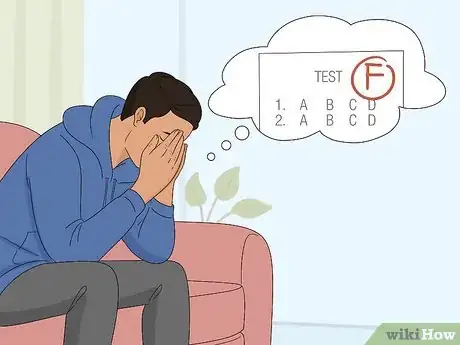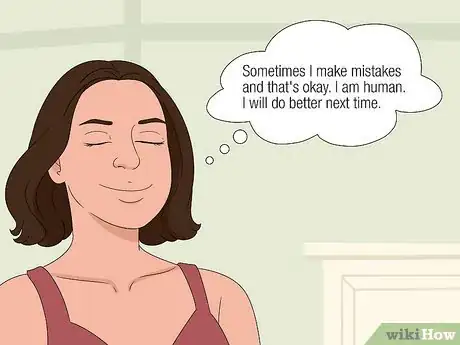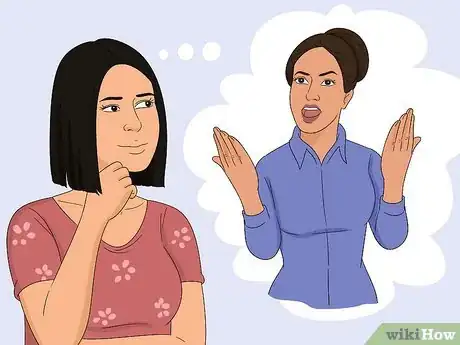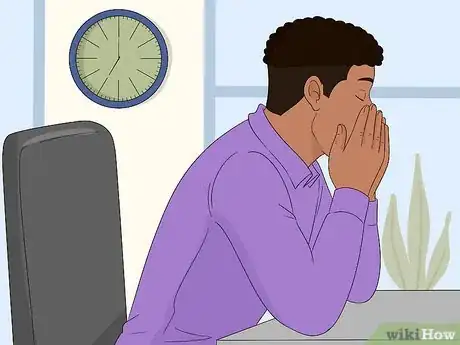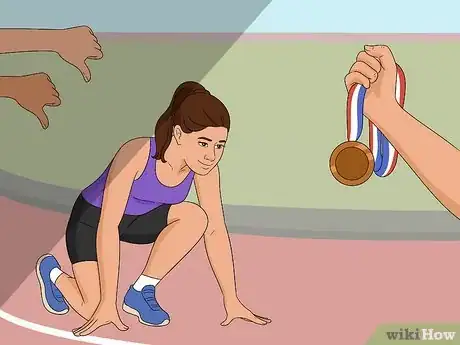This article was co-authored by Trudi Griffin, LPC, MS. Trudi Griffin is a Licensed Professional Counselor in Wisconsin specializing in Addictions and Mental Health. She provides therapy to people who struggle with addictions, mental health, and trauma in community health settings and private practice. She received her MS in Clinical Mental Health Counseling from Marquette University in 2011.
There are 11 references cited in this article, which can be found at the bottom of the page.
This article has been viewed 114,590 times.
Everyone has bad thoughts from time to time — it's perfectly normal. You might be stressed out about an upcoming interview or presentation, or you might just have an embarrassing memory that you wish you never had to think about again. This article provides methods for dealing with unwanted thoughts so they don't take over your mind. You may not able to completely block counter-productive thoughts, but you can deal with them healthfully by identifying them, challenging them, practicing techniques for reducing them, coping with and accepting them, and getting social support for them.
Steps
Identifying and Challenging Unhelpful Thoughts
-
1Identify the thoughts you want to change. In order to change your thinking you need to know the exact thoughts and thought patterns that are troubling you or causing emotional distress.[1]
- Some examples of counter-productive thoughts are, “I am stupid. I can't do anything right. I know I am going to fail. I know that person hates me. I hate that person.”
- There are also specific types of thinking habits or patterns like catastrophizing, which means you often think the worst-case scenario will occur. Other thinking patterns include over-generalizing (thinking in always or never, such as, “I always mess things up.”), mind-reading (thinking you know what someone else is thinking such as, “I know he hates me”.), and predicting the future (thinking you know what will happen such as, “I am going to lose”).
- Make a list of the thoughts and thought patterns you want to change so that you can refer to them later.[2]
- Write down which patterns or habits you tend to have.[3]
- Be aware that some thoughts that may be considered "bad" are simply part of human nature, e.g. sexual thoughts, or "what if" scenarios that stem from our desire for personal safety. These thoughts are okay to have, and normal, and come from good instincts (like to procreate or protect ourselves and loved ones).
- If these thoughts become intrusive or interfere with your daily life, then you may need to address the obsessive nature of the thoughts. But remember, that still doesn't make the thoughts themselves bad.
-
2Change your bad thoughts. After you have identified your bad thoughts and thinking patterns, you can begin in develop alternative thoughts.[4]
- Notice when you have an unhelpful thought. Identify the thought and then change it to something more realistic and appropriate. For example, if you thought, “I never do anything right,” change this thought to something more accurate such as, “Sometimes I make mistakes and that's okay. I am human. I will do better next time.”
- Catch yourself when you think a bad thought and say to yourself, “Wait a second! That is not a good thought and it's not true. I know I can turn this thinking around to something positive.”
- A therapist who specializes in Cognitive Behavioral Therapy (CBT) may be able to help you with this process and give you additional techniques to try. (Note: CBT is not for everyone and for some psychological conditions a more nuanced approach is needed. Keep in mind that all therapists are human, and may not understand your condition. Try to find a therapist who admits that they do not have all the answers for everyone.)
Advertisement -
3Substitute positive wording and imagery for negative ones. For example, if someone tells you not to slam the door, the first thing your mind does is imagine a door slamming. When you frame something with a negative grammatical construction — “don't think about X” — your brain has to think about that thing in order to remind itself not to. Subvert this by mentally replacing the undesired outcome with the desired outcome.
- For example, if you're worried about a job interview, don't think: “Don't forget my portfolio.” Think: “Remember your portfolio.” Instead of “Don't blow it,” think, “I'm going to nail it.”
-
4Consider the best-case scenario.[5] If you cannot stop worrying about how something could go wrong, flip the script and focus, instead, on the most positive possible outcome in that situation. Instead of trying to ignore the thing that is causing you stress, guide your thoughts in a direction that causes you less stress and anxiety.
-
5Address bad thoughts about other people. If your bad thoughts are about someone else ("I hate that person") ask yourself why you had that thought. Did this person do something bad to you? Is he or she abusive? Or is it something within you, like you're jealous of him or her? When you have these thoughts, examine your own emotions. What are you feeling right now? Do you feel insecure, powerless, or isolated?
- Try to figure out where these feelings come from. Did your parents always measure you against your perfect older sister? Try to shift your attention away from what others are doing and understand what is happening with you when you have those thoughts.
- Practice empathy by imagining sympathetic reasons for their behavior.[6] Maybe you had a judgemental thought about your overweight friend, not realizing he's been busy caring for his sick grandmother and doesn't have time to exercise. Or maybe the person who was rude to you is suffering from chronic pain and lashing out because she's hurting. It doesn't need to be an accurate reason, but it might be enough to keep you calm and allow you to move on.[7]
Practicing Techniques for Reducing Bad Thoughts
-
1Create a worry period and postpone the bad thought.[8] Research shows that one of the most effective ways to deal with an unwanted thought is to simply let it run its course. However, that doesn't mean you necessarily have time to do that in any given moment. Create a "worry period," a set time each day when you are allowed to worry. Consider the rest of your day a worry-free zone.[9]
- Set your worry period for the same time each day and early enough that it won't make you anxious right before bed.[10]
- If a bad thought comes into your mind, notice it and tell yourself you will worry about it later. You can even keep a notebook to jot it down or simply say to yourself: "I want to remain calm. I will come back to this later." It may or may not come up again.[11]
- If the thought returns, make a tick next to it in your notebook. Say to yourself, "Yes, I will get to you, just not right now."
- Go over your list during your designated worry period. If the bad thoughts or worries still bother you, then go ahead and worry about them, but only for the set worry period. If they no longer bother you, cross them off and move on.[12]
- Postponing your worries will break the habit of dwelling on bad thoughts and disrupting your day, but at the same time you're not battling to suppress or block the thought.[13] If the thought continues to arise repetitively, you may need to discuss it with a mental health professional.
-
2Observe the bad thought but choose not to engage it. For instance, when the unhelpful thought occurs, make a mental note that it did occur. It might be something you say out of habit to yourself, or it might be something in your environment, something someone said or did, that triggered a bad memory.
- When people remember the bad memory AND engage in it, they relive the memory, emotions and all, unless they are aware that they are being triggered.
- Once you become aware, you can work on postponing the bad thought, as described above. You can acknowledge that yes, bad things have happened in your life, and you understand why you were reminded of this memory in this instance, but you practice (or at least consider) putting it aside for the moment instead of reliving the memory all over again.
Coping with and Accepting Bad Thoughts
-
1Accept that it's a challenge to block unwanted thoughts. Research has shown that people have a more difficult time blocking unwanted thoughts when they believe that they should be able to do so easily.[14] When it was explained to them that blocking any though, even positive ones, is difficult, it was much easier for them to block out the thoughts they wanted to ignore. So relax, and don't put so much pressure on yourself. The pressure will only bring bad thoughts back to you!
-
2Let them run their course. Research has shown that if we try too hard to distract ourselves from otherwise normal unpleasant thoughts, our minds can focus on them so much that they become destructively bad, obsessive thoughts. Another study showed that subjects who distracted themselves from bad thoughts with music were eventually soured on the experience of music itself.
- A normal unpleasant thought might be a "what if" scenario about something undesirable happening, like a burglary. This is, in fact, a very natural, and useful thought, as it can remind us to lock our doors and windows at night and not take risks with our safety or the safety of those we love. It's when this thought becomes irrational – you never leave your house, buy two pitbulls, and install a security system even though you live in a quiet, low-crime neighborhood – that it reduces your quality of life.
- Instead of trying to distract yourself every single time you have a bad thought, let them run their course.
- If it is a normal unpleasant thought, you can acknowledge it and, if necessary, take action (your thought about being burglarized reminds you that you didn't lock the back door, so you go and lock it.) You can also try thanking your brain for trying to protect you, and move on.
- If the thought does not go away, then you can practice the process outlined in methods one and two to help you resolve them.
-
3Create coping strategies. We all have undesirable or counter-productive thoughts from time to time. It will be easier to deal with bad thoughts if you have a plan in place for how you'll react if they pop into your mind unbidden. Your strategy should follow the formula: “If X thought pops into my mind, I will do Y action.”[15]
- The action might be as simple as, "I will acknowledge it and not engage with it at the moment."
- You might get up and do a physical activity that occupies your mind every time you have a bad thought — 50 jumping jacks, for example.
- Use coping strategies to deal with undesirable or counter-productive thoughts and emotions such as: getting out in nature, creating art, writing, exercising, or praying.
-
4Practice meditation and mindfulness. Mindfulness-based meditation is a great way to deal with bad thoughts. It will not "clear your mind" or stop the bad thoughts – it's impossible to control what might pop up in your mind, but it teaches you to examine those thoughts in a calm, objective manner. With practice, you will learn to dismiss the bad thoughts as they arise.[16]
- Find someplace with as few distractions as possible.
- Sit in a chair with your back straight, with your hands resting on your thighs.
- Close your eyes and focus on the blackness. If you see colors in the darkness, you can focus on those.
- Try to simply be aware of the present moment: how your body feels, the thoughts that come and go. The idea is to be in that moment with whatever thoughts may arise.
- When negative thoughts come, acknowledge them and try to examine them with detached curiosity. Where did this thought come from? Why do you believe this particular thought? Remind yourself that thoughts and feelings are impermanent, and your bad thoughts are not who you are.
- Do this for 20 minutes every day. Again, it will take some time to be able to observe your negative thoughts with detachment.
-
5Keep a journal. Sometimes, writing an idea down and fleshing it out on the page helps your mind work through its problems. If a bad thought keeps coming back to you, journal about it. Keep journaling every day until the idea no longer takes up so much space in your mind.
-
6View your thoughts as hypotheses. Don't make bad thoughts more important than they are. This is called cognitive diffusion.[17] Everyone has thoughts that they don't want — it's nothing special. In fact, the simple act of not wanting a thought makes it take center stage in your mind, even if it's not a particularly bad thought. For example, try not to think of a cute puppy right now!
- Do your best not to make a mountain out of a molehill.
- Accept that having a bad thought says nothing about you as a person, and it will leave your mind more quickly.
Getting Outside Help with Bad Thoughts
-
1Get social support. Having social support can help people be able to cope with negative thoughts.
- Ask friends, family, significant others, teachers, colleagues, or other trusted individuals for support or help dealing with your negative thoughts.
- Get another opinion. If you find yourself unable to change your negative thinking – ask others to help come up with alternative ways of thinking. You might be surprised at how helpful it can be.
-
2Surround yourself with positive friends. If you're constantly around people who complain and find the worst in a situation, you'll tend to think like that, too. Cut the negative influences from your life, and spend your time with people who put you in a positive frame of mind. When bad thoughts aren't part of your regular conversations, they won't be a regular part of your thinking habits either.
-
3Seek cognitive-behavioral therapy (CBT). If bad thoughts are interfering with your ability to live your life happily, and nothing you do on your own seems to be making a difference, then you may benefit from seeking help from a licensed professional (therapist or psychologist). Therapists will be able to help you work through your bad thoughts in a structured, safe way.
- Cognitive Behavioral Therapy (CBT) is a treatment approach that focuses specifically on changing negative thinking in order to improve emotions and behaviors. This is exactly the type of treatment that can help you learn to deal with bad thoughts. CBT has also been shown to help many different mental health issues such as depressive disorders, anxiety disorders and post-traumatic stress disorder (PTSD). Ask your therapist if she can use CBT in your treatment.
- Remember that therapy is not a quick fix. A handful of appointments with a therapist will not make bad thoughts go away.
- Be patient and stick with your therapist and your treatment plan to help you deal with bad thoughts more constructively.
References
- ↑ http://www.getselfhelp.co.uk/docs/AutomaticThoughts.pdf
- ↑ http://www.getselfhelp.co.uk/docs/UnhelpfulThinkingHabits.pdf
- ↑ http://www.getselfhelp.co.uk/docs/ThoughtRecordSheet7.pdf
- ↑ http://www.getselfhelp.co.uk/docs/FindingAlternativeThoughts.pdf
- ↑ http://www.learnmindpower.com/using_mindpower/eliminating_negative_thinking/
- ↑ http://www.kindspring.org/story/view.php?op=sg&sid=12742
- ↑ http://www.kindspring.org/story/view.php?op=sg&sid=12742
- ↑ http://www.helpguide.org/articles/anxiety/how-to-stop-worrying.htm
- ↑ http://www.helpguide.org/articles/anxiety/how-to-stop-worrying.htm
- ↑ http://www.helpguide.org/articles/anxiety/how-to-stop-worrying.htm
- ↑ http://www.helpguide.org/articles/anxiety/how-to-stop-worrying.htm
- ↑ http://www.helpguide.org/articles/anxiety/how-to-stop-worrying.htm
- ↑ http://www.helpguide.org/articles/anxiety/how-to-stop-worrying.htm
- ↑ http://www.psychologytoday.com/blog/the-science-success/201004/yes-you-can-stop-thinking-about-it
- ↑ https://www.psychologytoday.com/blog/the-science-success/201004/yes-you-can-stop-thinking-about-it
- ↑ http://people.uncw.edu/hakanr/documents/mindfulandlettinggoofnegthought2007.pdf
- ↑ http://scholarworks.gsu.edu/cgi/viewcontent.cgi?article=1083&context=psych_facpub
